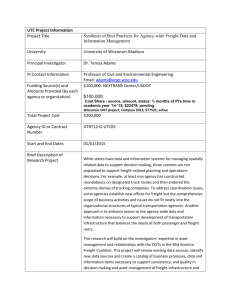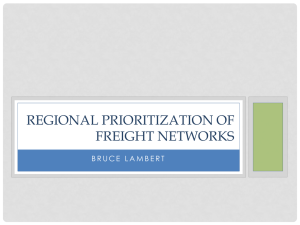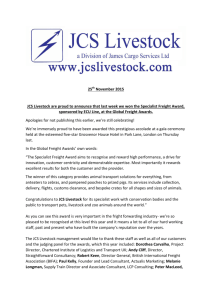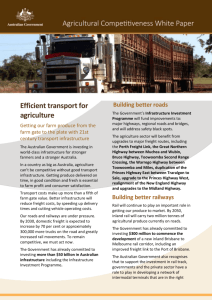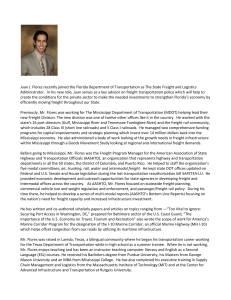Freight Analysis - Northwest Commission
advertisement
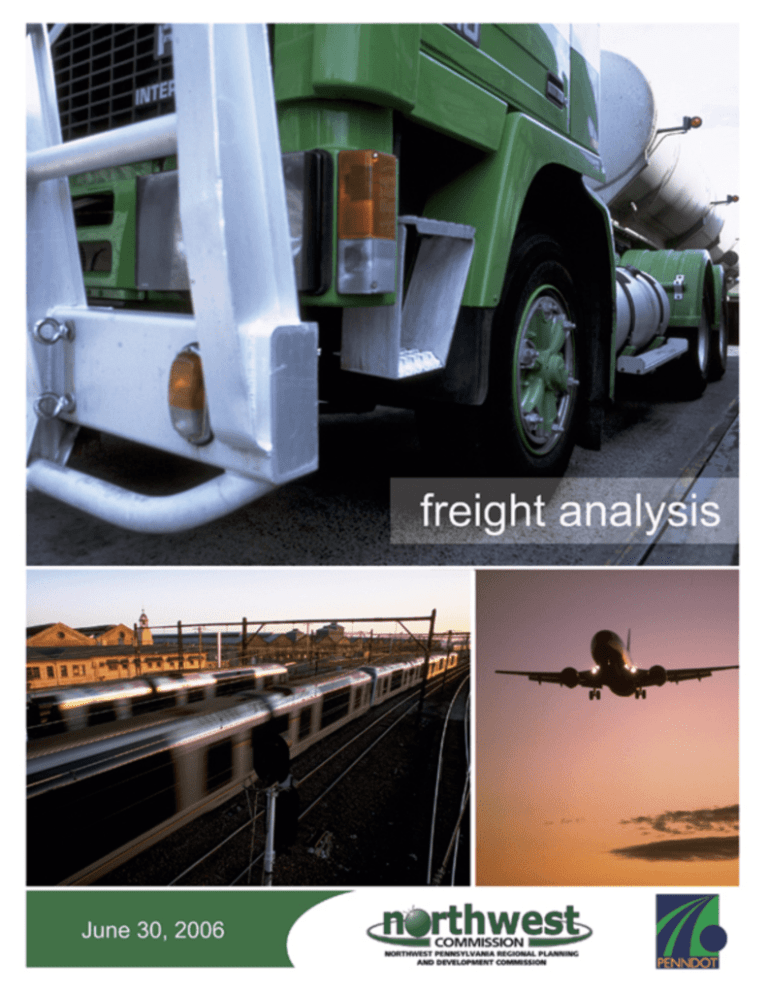
Introduction Efficient goods movement is key to economic vitality. The purpose of this study is to analyze both inbound and outbound freight movements by commodity and merchandise in Clarion, Crawford, Forest, Venango and Warren counties. According to the U. S. Department of Transportation (USDOT) Freight Analysis Framework, the U. S. transportation system carried over 15 billion tons of freight valued at over $9 trillion in 1998. Domestic freight movements accounted for nearly $8 trillion of the total value of shipments. By 2020, the U. S. transportation system is expected to handle cargo valued at nearly $30 trillion. The nation’s highway system, and our enormous truck fleet, moved 71 percent of the total tonnage and 80 percent of the total value of U. S. shipments in 1998. (Figure 1) Although trucks made the base majority of local deliveries, they also carried large volumes of freight between regional and national markets. Water and rail also moved significant shares of total tonnage, but they accounted for much smaller shares when measured on a value basis. As expected, air freight moves less than 1 percent of total tonnage but carried 12 percent of the total value of shipments in 1998. Domestic freight volumes will grow by more than 65 percent, increasing from 13.5 billion tons in 1998 to 22.5 billion tons in 2020. The forecast shows that the air and truck modes will experience the fastest growth. Domestic air cargo tonnage is projected to nearly triple over this period, although its share of total tonnage is expected to remain small. Trucks are expected to move over 75 percent more tons in 2020, capturing a somewhat larger share of total tonnage. (Figure 2) While volumes moved by the rail and domestic water modes are also projected to increase over the forecast period, they will not grow as dramatically primarily because of anticipated slower growth in demand for many of they key commodities carried by these modes. International trade accounted for 12 percent of total U.S. freight tonnage in 1998 and is forecast to grow faster than domestic trade. International trade is projected to increase by 2.8 percent annually between 1998 and 2020, nearly doubling in volume. This growth in international trade is likely to present challenges to U.S. ports and border gateways. Figure 1. Freight Flows by Truck 1998 (tons) Figure 2. Freight Flows by Truck: 2020 (tons) Funds for transportation system improvements are constrained, therefore, the results of this study are crucial to effective decision making on investments to maintain capacity of the five county transportation system. Freight in this region is shipped via truck, rail and air. Truck is the primary mode; therefore, it is paramount that the highway network is well maintained. Regional Freight Movement Truck, rail and air freight service is available in the Northwest RPO. Similar to Pennsylvania and the United States, the majority of freight is moved by truck in terms of tonnage and value. Figure 3 indicates freight flow by truck. Factors that influence modal choice include commodity, distance and rates. Although most freight is shipped by truck, some of the areas businesses could not survive without rail. In a Northwest Commission rail study done in 2002 some companies stressed that there was “no alternative method of transportation of their goods”. Air freight accounts for less than 1% of freight movement. However, like rail some businesses would not be able to operate without access to this mode. Commodity Groups Table 1 shows the top ten commodity groups shipped to, from and within the Northwest RPO by truck. Petroleum refining products are the top commodity by weight and value. (Table 1) Commodity Truck Tons Petroleum Refining Products Broken Stone or Riprap Gravel or Sand Warehouse & Distribution Center Misc. Industrial Organic Chemicals Ready-mix Concrete, Wet Bituminous Coal Blast Furnace or Coke Asphalt Paving Blocks or Mix Primary Forest Materials 616,564 545,435 394,020 384,346 61,325 56,470 44,899 28,288 24,071 20,605 These commodities are similar to the top five commodities for Pennsylvania shown in Table 2. 2006 NW RPO Freight Analysis 62 6 19 79 8 6 322 322 6 27 77 8 36 62 66 62 36 8 322 80 68 66 Tonage Per Highway (2004) 0 - 548,312 tons 548,313 - 2,549,697 tons 2,549,698 - 5,649,992 tons 5,649,993 - 21,209,258 tons 21,209,259 - 145,250,241 tons * Source: Global Insight (Transearch 2004) Figure 3 2006 NW RPO Freight Analysis WARREN CRAWFORD FOREST VENANGO CLARION Origination vs. Destination Origin Loads Destination Loads * Source: Global Insight (Transearch 2004) Figure 4 Table 2 - Top Five Commodities Shipped To, From, and Within Pennsylvania by All Modes: Commodity Nonmetallic Minerals Coal Crude Petroleum/Natural Gas Petroleum/Coal Products Clay/Concrete/Glass/Stone Figure 4 shows origin and destination loads. All five counties are similar in that origin loads account for approximately 60% of freight traffic. (Figure 4) Freight Analysis Understanding freight activity is important for matching infrastructure supply to demand and for assessing potential investment and operational strategies. As previously mentioned, truck is the predominate freight mode in the Northwest RPO region. Figure 5 shows the National Highway System designated highways in the region. (Figure 5) A comparison of this with figure 3 shows that in general roads with the highest freight tonnage are also on the National Highway System. The most notable exception is Route 36 in Clarion and Venango counties and Route 8 in Crawford County and Route 6/19 in Crawford County. The majority of highway and bridge projects on the Northwest Commission’s Transportation Improvement Program also coincide with roads which carry the most freight. These include Interstates 79 and 80, Route 322 in Clarion and Venango Counties and Route 6 in Warren County. Freight generated within the region is primarily associated with manufacturing. Primary products include mobile/modular homes, petroleum products, machined metal products, sand and gravel and hardwood and lumber. Distribution of these production facilities is generally evenly spread throughout the region. Inbound freight is also generated by these industries. However, it should be noted that warehouse and distribution centers ranked fourth overall in terms of commodities which in this region translates into retail. Figure 6 shows the location of businesses or institutions with fifty or more employees in the region. (Figure 6) National Highway System 6 62 19 79 6 6 6 322 322 62 19 62 8 322 80 Figure 5 Several studies conducted over the past five years have surveyed business, economic development agencies and transportation providers concerning needed system improvements. Recommendations were understandably geared toward specific industry needs and included easing horizontal and vertical curves, shoulder improvements, replacement of weight posted bridges and adding truck climbing lanes. In addition to expressing concerns about the highway network, mention was made about other modes as shown by the following quote from Analysis of the Transportation Needs of the Wood Products Industry in Distressed Appalachian Regions. “Responding hardwood manufacturers reported 93% of their products by volume were shipped by truck in 2004 to domestic markets. Seven percent of their product was shipped by rail in the domestic market. Responding hardwood manufacturers did not transport any products by barge or ship to domestic markets. Due to steadily increasing trucking charges, only partially caused by fuel cost spikes, respondents identified impediments to rail and inland waterway alternatives yet stressed their competitive need for more reliable and cost efficient access to their domestic and international markets”. As previously mentioned, highway and bridge projects on the Northwest RPO TIP conform with routes most heavily used for freight shipments. An analysis of prior investments also conform with these routes. Most Keystone Opportunity Zones, industrial parks and enterprise zones are well served by the highway network. It is anticipated that future freight volume in this region will increase in similar fashion to state and national patterns. A proposed bio-diesel production facility in Rouseville which adjoins Oil City will dramatically increase rail freight on the Norfolk Southern line from Rouseville to Meadville. An estimated 150 carloads per month will be needed to supply the plant once it is in full operation. Although interstate highway freight movements are largely through shipments, most goods imported to or exported from the region utilize that system. Conclusion Freight transportation is integral to increased economic development and improved quality of life. A thorough understanding of freight movement is key to enhancing these aspects of our region and in identifying ways to improve transportation system efficiency. Since the majority of freight is shipped by truck investment in highway and bridge projects should follow that modal choice. Rail and air are critical to some industries and have to be maintained albeit at a lower level of investment. In general, past and present TIP projects have benefited those corridors which have the highest freight volumes. The results of this study will assist the Northwest RPO’s Transportation Advisory Committee in prioritizing projects on future TIP’s and the Long Range Plan. 2006 NW RPO Freight Analysis 62 6 Warren 79 8 19 6 6 27 77 Meadville Titusville 322 322 8 Cochranton 36 62 Tionesta 66 Oil City Franklin 62 Seneca 36 8 322 Clarion 80 68 66 New Bethlehem Company/Organization w/ 50+ Employees Figure 6


